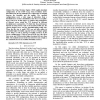Free Online Productivity Tools
i2Speak
i2Symbol
i2OCR
iTex2Img
iWeb2Print
iWeb2Shot
i2Type
iPdf2Split
iPdf2Merge
i2Bopomofo
i2Arabic
i2Style
i2Image
i2PDF
iLatex2Rtf
Sci2ools
VTC
2010
IEEE
2010
IEEE
Internet Access Performance in LTE TDD
The Time Division Duplex (TDD) uplink-downlink configuration of the 3GPP Long Term Evolution (LTE) determines how the ten subframes in a radio frame are divided between the downlink and the uplink. The specified configurations cover a wide range of allocations from a downlink-heavy resource distribution ratio (9:1) to an uplinkheavy ratio (2:3). In this paper, we compare the performance of Internet access using the TCP protocol in different downlink-heavy asymmetries. We find that the performance depends on many factors such as the transferred file size, the control channel errors and the downlink/uplink traffic mix. When the file size is small, TDD can not fully utilize its potentially higher downlink capacity because of longer uplink access delays as well as shortage of uplink resources in the chosen configurations. With an increased file size, this effect fades away and TDD provides higher download bit rates than FDD. The realized increase in bit rate is however not as high as the c...
| Added | 31 Jan 2011 |
| Updated | 31 Jan 2011 |
| Type | Journal |
| Year | 2010 |
| Where | VTC |
| Authors | Riikka Susitaival, Henning Wiemann, J. Ostergaard, Anna Larmo |
Comments (0)

